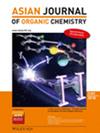Pd(II)催化串联分子内氧化Heck反应/C - H芳基化序列:一锅合成3 -硝基- 2 -芳基-吲哚
IF 2.8
4区 化学
Q1 CHEMISTRY, ORGANIC
引用次数: 0
摘要
本文描述了一种Pd(II)催化的级联方法,该方法通过分子内氧化Heck型C - C偶联和NO2定向选择性C - 2芳基化,在原位形成3 -硝基吲哚与卤代芳烃之间进行一步反应。重要的是,这种高效和原子经济的级联方案使用相同的催化剂体系,并在一个步骤中提供了多种特权的C - 2 -芳基-硝基吲哚支架(5 a - 5 aa),具有良好的收率。机制研究,包括自由基捕获、控制、竞争实验以及EDGs和EWGs效应的研究,强烈表明参与了σ -键的转化或碱加速质子的提取,随后形成了一个关键的中间产物。一个高活性的Ar - Pd - C - 2 -硝基吲哚配合物,这进一步表明NO2基团在提高效率和区域选择性方面的重要作用。此外,该级联方案适用于结构复合物C‐5功能化(−F/‐Cl/‐Me/‐OMe) C‐2芳基‐硝基吲哚的“一锅”合成,在生物和制药领域具有巨大的潜力。本文章由计算机程序翻译,如有差异,请以英文原文为准。
Pd(II)‐Catalyzed Tandem Intramolecular Oxidative Heck Reaction/C−H Arylation Sequence: One‐Pot Synthesis of 3‐Nitro‐2‐Aryl‐Indoles
The present article describes a Pd(II)‐catalyzed cascade methodology that proceeds in a one‐step sequence via intramolecular oxidative Heck‐type C−C coupling and NO2‐directed selective C‐2 arylation of in‐situ formed 3‐nitroindoles with haloarenes. Importantly, this highly efficient and atom‐economical cascade protocol utilizes the same catalyst system and affords a diverse library of privileged C‐2‐aryl‐nitroindole scaffolds (5 a–5 aa) in a single step with good to excellent yields. Mechanistic investigations, including radical trapping, control, competition experiments and studies on the effects of EDGs and EWGs, strongly suggest the involvement of σ‐bond metathesis or a base accelerated proton abstraction, followed by the formation of a key intermediate i. e., a highly reactive Ar‐Pd−C‐2‐nitroindole complex, which further signifies the vital role of the NO2 group in leading the efficiency and regioselectivity of the protocol. In addition, this cascade protocol is applicable in the ‘one pot’ synthesis of architecturally complex C‐5 functionalized (−F/‐Cl/‐Me/‐OMe) C‐2‐aryl‐nitroindoles and offers great potential in terms of biological and pharmaceutical fields.
求助全文
通过发布文献求助,成功后即可免费获取论文全文。
去求助
来源期刊

Asian Journal of Organic Chemistry
CHEMISTRY, ORGANIC-
CiteScore
4.70
自引率
3.70%
发文量
372
期刊介绍:
Organic chemistry is the fundamental science that stands at the heart of chemistry, biology, and materials science. Research in these areas is vigorous and truly international, with three major regions making almost equal contributions: America, Europe and Asia. Asia now has its own top international organic chemistry journal—the Asian Journal of Organic Chemistry (AsianJOC)
The AsianJOC is designed to be a top-ranked international research journal and publishes primary research as well as critical secondary information from authors across the world. The journal covers organic chemistry in its entirety. Authors and readers come from academia, the chemical industry, and government laboratories.
 求助内容:
求助内容: 应助结果提醒方式:
应助结果提醒方式:


